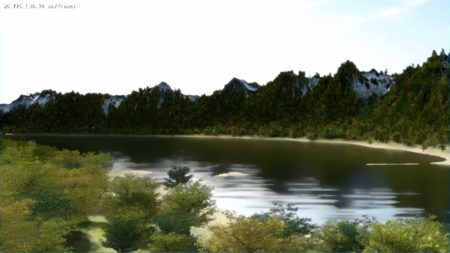This week at SIGGRAPH 2018, Chaos Group unveiled the work behind Project Lavina, a groundbreaking new technology designed for photorealistic real-time ray tracing. Often called the “Holy Grail” of computer graphics, Project Lavina leverages dedicated RT Core within NVIDIA’s Turing-based Quadro RTX GPUs to radically change the direction of computer graphics.
Project Lavina—The Details
Named after the Bulgarian word for “avalanche” Project Lavina demonstrated in its SIGGRAPH demo a massive 3D forest and several architectural visualizations running at 24-30 frames per second (FPS) in standard HD resolution. The technology does not use game engine shortcuts like pre-rendered (baked) rasterized imagery or reduced level of detail. Lavina is able to handle massive scenes at unprecedented real-time speeds—calculating over 300 billion triangles in one case without any loss in detail.

01 – Project Lavina is the code name for the just unveiled real-time ray tracing technology by Chaos Group at SIGGRAPH 2018.
“We’ve been developing ray tracing technology for 20 years, and this is one of the biggest breakthroughs we’ve ever made,” said Vlado Koylazov, co-founder, and CTO of Chaos Group. “Real-time and ray tracing coming together is the beginning of something big.”
Utilizing NVIDIA Tech
Project Lavina leverages dedicated RT Core in Turing-based Quadro RTX GPUs.
“We are thrilled to see how well Project Lavina takes advantage of the RTX stack debuting on our new Quadro RTX line,” said Bob Pette, vice president of Professional Graphics, NVIDIA. “True real-time ray tracing is our goal with RTX, and it’s great to see a market leader like Chaos Group achieve it with us.”
The SIGGRAPH tech demo uses 3D scenes exported from V-Ray-enabled applications directly in Lavina. Unlike a traditional game engine which requires assets to be rebuilt and specially optimized, Lavina dramatically simplifies this process with direct compatibility and translation of V-Ray assets. Upon loading the scene, the user can explore the environment exactly as they would in a game engine, and experience physically accurate lighting, reflections, and global illumination.
02 – This video is the SIGGRAPH demo of Project Lavina. Be sure to check this out.
This is Chaos Group’s second real-time announcement in the last year, following the beta release of V-Ray for Unreal. Seeing a growing demand for real-time applications, Chaos Group has developed a way to tie ray tracing to both kinds of workflows, upping the fidelity of this emerging medium. Soon, users will be able to apply the most realistic style of rendering to every type of interactive project, including 3D configurators, virtual productions, and VR, using the toolset they like best.
“This breakthrough was made possible by partnering with NVIDIA, whose Quadro RTX GPUs helped unlock the next level of real-time experiences,” said Peter Mitev, CEO of Chaos Group. “From here, Project Lavina’s mission will be to focus on pushing the quality and speed of real-time ray tracing.”
To learn more about Project Lavina go here.
Architosh Analysis and Commentary
Lavina leverages NVIDIA’s new class of GPUs known as Turing GPU generation. These GPUs have dedicated silicon designed specifically for ray tracing. This is NVIDIA’s “RT Core” and the company has just announced the arrival of Turing class GPU technology to the market.
RT Cores in Turing class GPUs make real-time ray tracing possible by using new Tensor Cores for AI (artificial intelligence) inferencing. This is big-time exciting stuff and changes the game in rendering.



Reader Comments
Comments for this story are closed